Plug Fishing For Salmon: 10 Best Tips For More Fish
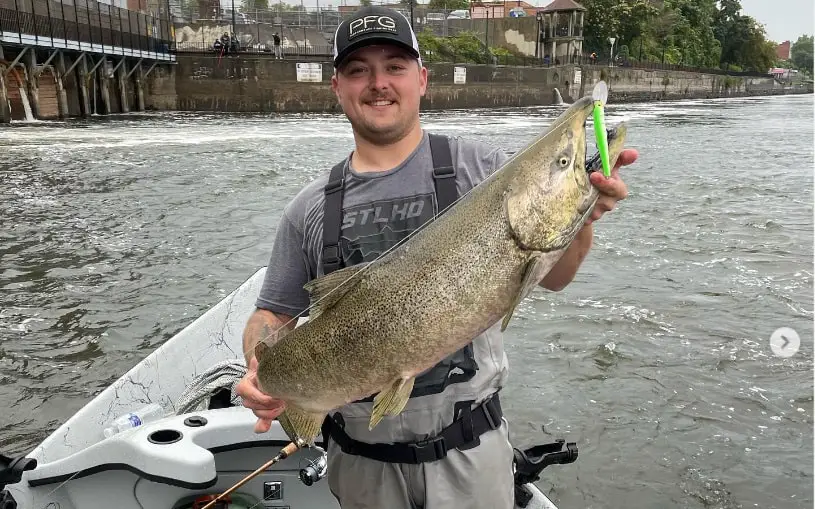
This article is about plug fishing for salmon in rivers with an emphasis on plug fishing from a boat. My knowledge of plug fishing is gained from years of guiding and learning different methods from other successful guides and plug fishermen.
The lures and setup are proven to be effective, and I’ll go over this and everything else you need to know to increase your chances of catching more salmon on plugs.
How To Effectively Fish Plugs For Salmon: 4 Methods
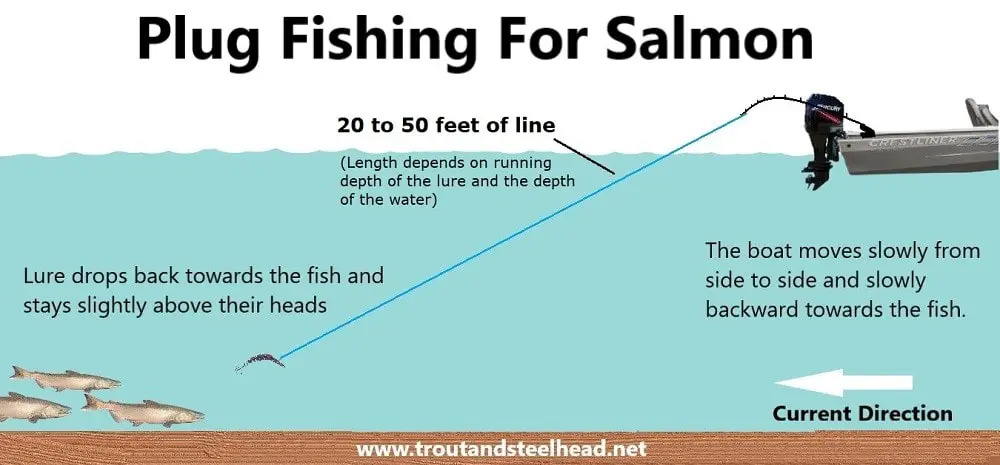
Plugs are a type of wobbling lure that entices salmon to bite. Plug fishing for salmon involves presenting plugs out of the back of the boat, often using a method known as back trolling or just regular trolling. Plugs can also be cast from the bank or when wading.
1. Back Trolling Plugs
In the river, most anglers fish plugs using the back trolling method, which involves running plugs out of the back of the boat and slowly sliding the boat downriver towards the holding salmon. This article is primarily about this style of plug fishing.
2. Casting Plugs
I cast a lot of plugs from the bank or when wading with clients. Plugs can work anywhere when casting, but they work best in water from 5 to 15 feet deep. Casting plugs involves casting the plug out and across the river and then swinging the plug, or slowly reeling the plug in.
3. Trolling Plugs
Trolling plugs involves moving the boat in a forward direction while pulling plugs.
You can flatline plugs for shallow fishing, or you can run plugs off of a downrigger ball for deeper water fishing.
For deep water, you can also use Dipsy Divers or Jet Divers to get your plugs deep.
Anglers and guides will also use surface side planers to spread the plugs and other lures out to cover more water. See Trolling For Salmon.
4. Back Bouncing Plugs
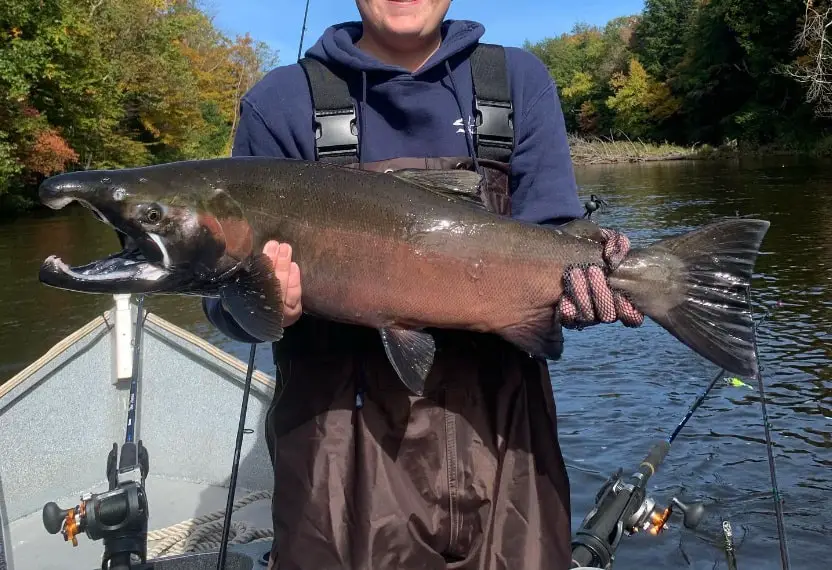
I’m not going to get into it, but back bouncing plugs is another method used by anglers.
Back bouncing involves anchoring your boat above the target areas and using a heavy weight to anchor the plug or drag the plug down the river into the salmon hole.
The Set-up For Plugs
There is some essential gear that will help you catch more salmon.
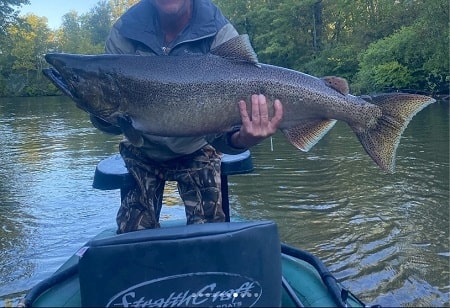
The Boat: Any small midsized fishing boat will work for salmon fishing with plugs. In my area, many guides use a drift boat to present lures and plugs.
I use a pontoon boat or inflatable raft for very shallow remote rivers that you can’t get a drift boat or motor boat into.
I have even seen anglers fishing plugs from fishing Kayaks and Canoes.
When fishing in large rivers out west like the Columbia River or the Frazer River in British Columbia, motor boats are the normal vessel.
The Rod: There are two tips I will give you about the best rods for plugs and other lures when back trolling. Plug rods should be medium soft action rod, with a good backbone to handle big fish, and should have a soft and sensitive rod tip
The second thing you should consider is to have all the rods and reels the same. The same rod, reel, line, and leader enable you to keep everything consistent when running multiple rods.
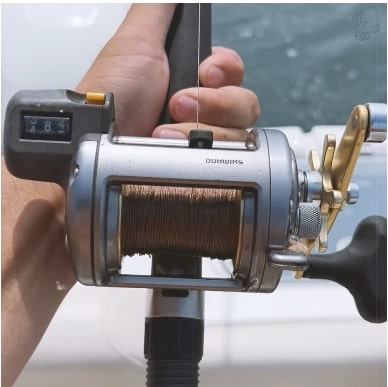
Reels: You can use spinning reels, low profile baitcasting reels, round baitcasting reel, or line counter reels.
For plug fishing, the best reels for precise presentation are line counter baitcasting reels. See Best Baitcasting Reels For Salmon.
Main Line: The recommended fishing line used for fishing plugs varies. Some anglers like a 40 to 50-pound mono or fluorocarbon main line, while others prefer a 50 to 65-pound braided line.
For the main line, I recommend a high-quality braided line in the 50 to 65plb size. Sufix 832 Advanced Supreme Braid, and P-Line’s Spectrex are good lines to consider.
Leaders: When fishing with plugs, a fluorocarbon leader of 30 to 40 pounds is necessary. Since the salmon are not line-shy with plugs, many guides like to use 40-pound leaders, so if they get snagged and pull hard enough, the lure’s hooks will bend so you can get your lure back.
Longer leaders of 3 to 6 feet are required, and the leader length often depends on the water clarity.
Other Gear: Rod holders, snap swivels, barrel swivels, stopper beads, and bead chains, are all things used when fishing salmon plugs.
Hooks: Hooks are also important. Many guides will remove the stock hooks that come on the plugs and replace them with a large single Gamakatsu Siwash hooks attached with a swivel. You want good hooks with a chemically sharpened hook point.
The Salmon Plugs
One of the most important parts of salmon fishing with plugs is the plugs you use. Salmon Plugs should be 4 to 6 inches long, and you should have a good selection of colors ranging from bright chartreuse, orange, and pink, to silver, gold, and darker colors like black.
The bigger the salmon or the dirtier the water, the bigger the plug. For big king salmon, big 5 to 6-inch plugs are the go-to sizes. When coho fishing, the coho will hit 4 to 5-inch plugs, and they will even 3-inch plugs when the water is clear, especially if you add a sardine fillet to the plug, which I’ll discuss below.
Some of my favorite and most effective salmon plugs are:
- Yakima Bait 4.5″ Mag Lip – The Mag Lip is my favorite all-around flatlining plug to fish. It’s good fished in slow to fast water spots.
- Luhr Jensen’s K16 and smaller K15 and K14 Kwikfish are great plugs for flat-lining in water under 14 feet deep. The bigger the plug, the deeper it dives. This is another very popular plug to fish.
- Yakima Bait’s T55 and T60 Flatfish – The M2 Size is smaller at 4.25″, which can be good in smaller clear rivers when salmon are holding. T50 is also good at 5 inches long.
- Trolling Plugs – Trolling salmon plugs include Tomic Plugs, Lymans, Brads Super Cut Plug- J-plugs, and Dreamweaver Captians Plug. These are fat, flat-nosed plugs that are often used for trolling, but they can also be used to fish rivers with slower currents.
The Bite And The Hook Set
When salmon grab a plug, they are known to grab and release it, so these tips will improve your catch rate.
- Wait, wait, wait: Before you set the hook, wait, wait, wait for the salmon to be pulling line for a few seconds. Do not set the hook the second the salmon hits. Let the salmon take line. This gives a better hook set and allows the salmon to pull line so it is further downriver from your other plug lines.
- Use a rod holder: Even though many anglers love to hold the rod to feel the bite, the urge to set the hook the instant they feel the bite often ends in lost fish. Putting the rod in a rod holder helps resist setting the hook super fast. With rod holders, the salmon often hooks itself.
- Reel and Pull Hook Set: Often, the best hook set is to simply start reeling and lifting the rod to the side at the same time. Keep the rod to the side of the boat. A hooked salmon will stay hooked longer with this type of hookset.
Boat Control
Many anglers are in a rush, but when it comes to a very productive salmon hole, slower is better. A slow, methodical presentation, dangling the plug longer in the salmon’s face will trigger more bites than a quick moving lure. I’ve caught many salmon after stopping and holding the boat and plug steady for over 60 seconds.
Your speed must be slower than the current speed to keep the plugs running properly. If your speed is faster than the current, the plug will stop wobbling and stop diving.
This works especially well when the salmon are deep. They will shoot up to hit a stationary plug.
Length and Depth For Getting Down
You want your plug to dive deep so it’s 6 inches to 3 feet off the bottom at all times, which is the salmon’s strike zone. How deep your plug will dive depends on which lure you are using and how much line is out.
Many anglers think they need to have a lure over 60 feet behind the boat so the fish do not see the boat and get spooked. Often, it’s better to use a length of line that put your lure at the right depth instead.
The right lure depth used with a longer leader is more likely going to make a salmon hit than having your lures a mile back.
I’ve had salmon and steelhead smash lures 10 feet behind my boat.
Create what some call the wall of death. Regardless of how far your lures are set back behind the boat. Trigger the aggressive nature of the salmon by spreading all your lures out a few feet or more and set your lures all at the same length to create a wall of lures, aka “the wall of death.”
Guide Tips For Better Success
Wrap Your Plug: Almost all the guides I know wrap their plugs with some sort of fish, like a sardine fillet, tuna, herring, or prawn. Wrapping plugs add scent and texture that may entice the salmon to bite and then bite a second time if they don’t get hooked. Also, keep ’em fresh, which means replacing old wraps with new meat for scents.
Scent It Up: Anglers and guides will also use commercial scents to the wrap or directly to the plug.
Sticky Sharp Hooks: The hooks will dull as they hit rocks and drag bottom, so sharpen them often or replace them often. Sticky sharp hooks land more fish.
Max Out The Rods: I will use as many rods as permitted in my area and spread the rods and lines out as much as possible.
Tipping Plugs: Tipping plugs with pink Berkley steelhead worms or gulp worms is becoming popular with anglers who feel the spinning and wiggling worms trigger more fish to bite.
Where To Fish
You can fish plugs just about anywhere, but water in the 6 to 20 feet range is best. I look for seams, pockets, and drop-offs. I fish below rapids right into the tail-outs. I also look for travel routes that are often defined by the deeper side of the river with current.
Current break and bubble lines are great spots for salmon fishing.
I stay out of still water, back eddies, and boiling water or upwellings since the salmon don’t tend to like these areas.
See also: Plugging For Steelhead
Plug Fishing For Salmon Q&A
If you have a question or comment, or want to share some advice about plug fishing for salmon, let me know in the comments section below.
Tight Lines
Graham
